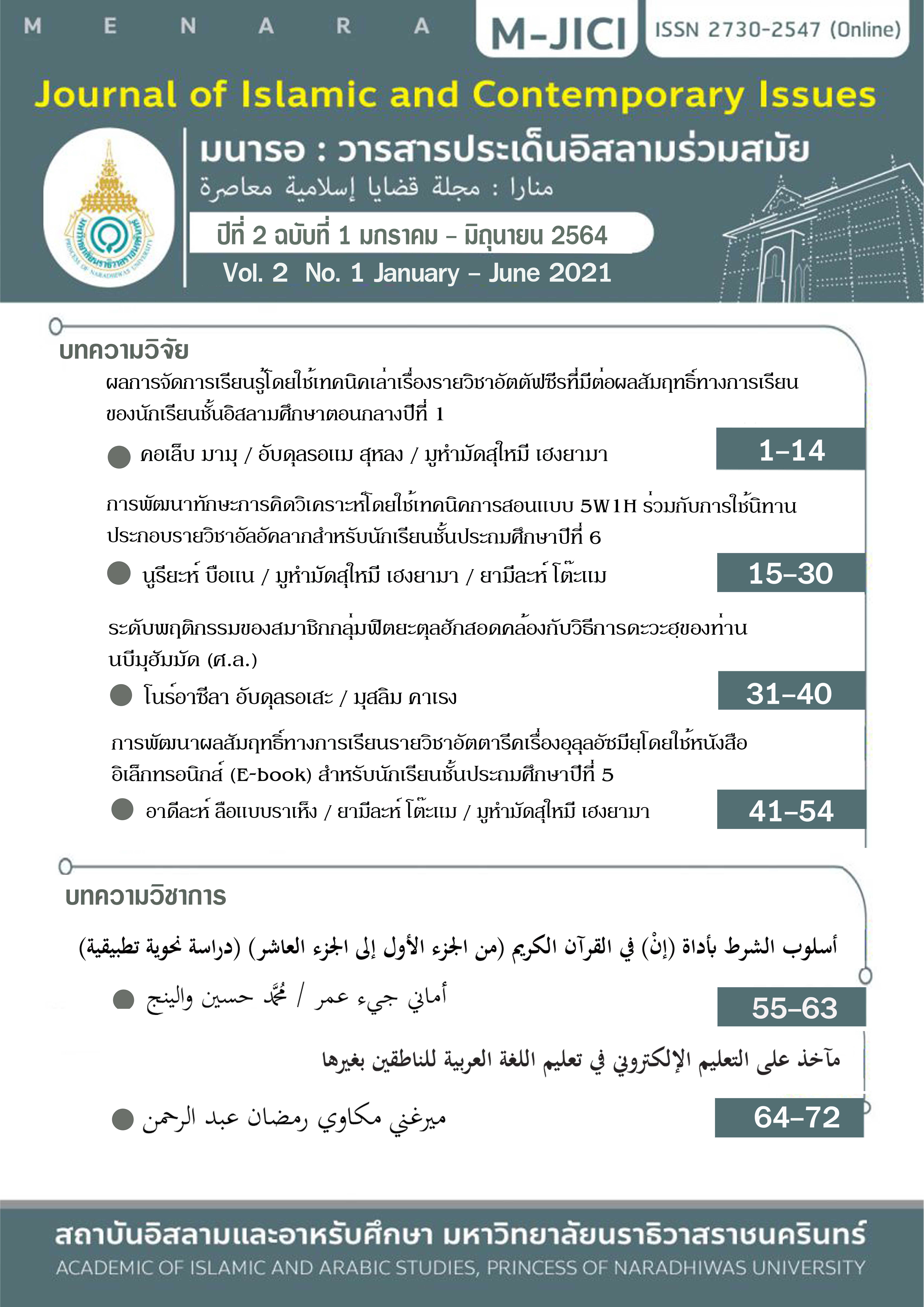The Behavioral Level among Members of Fityatulhaq Group in Accordance with the Methods of Dawah of Prophet Muhammad (PBUH)
Keywords:
Behavior, Dawah, FityatulhaqAbstract
These researches are qualitative and quantitative research aims to 1) Study the pattern and methods of Dawah of Prophet Muhammad (PBUH.) 2) Study the behavior level among members of Fityatulhaq group in accordance with the Methods of Dawah of Prophet Muhammad (PBUH). Data collected from the Qur'an, al Hadith, books, and historical texts that related research and obtained data were analyzed with content analyze. The quantitative data were collected from a sample of 97 of the 130 members of the Fityatulhaq group, compared with the table of Krejcie and Morgan and using a simple random sampling method. The data were analyzed using the SPSS program and presented as a percentage, mean and standard deviation. The results of this research showed that: 1) There are two methods of the Dawah of the Prophet Muhammad (PBUH), he used secret method and openly. The secret method is took 3 years for safety himself and others. He began his mission by inviting people who were in his family first and his friends to accept in Islam. He was used Arqam IbnArqam’s house as religious training. When he was openly instruction to Dawah, he officially proclaimed Islam by using his good ethics to know that he didn’t speak alone. He was also able to show his good manners to unbelievers that Islam taught only good things. 2) The behavior level among members of Fityatulhaq group in accordance with the methods of Dawah of Prophet Muhammad (PBUH) found that the overall level was at a high level. The mean is 4.32 and the standard deviation is 0.70.
References
ธานินทร์ ศิลป์จารุ. (2555). การวิจัยและวิเคราะห์ข้อมูลทางสถิติด้วย SPSS และ AMOS. กรุงเทพฯ: บิสซิเนสอาร์แอนด์ดี.
มะหะมัด คอยา และซาฝีอี อาดำ. (2562). ดะอวะฮฺด้วยหลักอัลวะศอฎียยะฮฺผ่านการนำเสนอคุฏบะฮฺวันศุกร์. วารสารอัล-นูร บัณฑิตวิทยาลัย, 14(26): 29-38.
ยุทธนา เกื้อกูล. (2550). วิทยาการสอนของท่านนบีมุฮัมมัด. วิทยานิพนธ์หลักสูตรปริญญาศิลปศาสตรมหาบัณฑิต สาขาวิชาอิสลามศึกษา มหาวิทยาลัยสงขลานครินทร์วิทยาเขตปัตตานี.
อับดุลลอฮมาลิก หมัดเหระ. (2556). การดูแลเยาวชนตามวิถีแห่งศาสนาอิสลามของผู้นำมุสลิมในสามจังหวัดชายแดนภาคใต้. วิทยานิพนธ์หลักสูตรปริญญาศิลปศาสตรมหาบัณฑิต สาขาวิชาอิสลามศึกษา มหาวิทยาลัยสงขลานครินทร์วิทยาเขตปัตตานี.
อิบรอฮีมม์ มายุดิน. (2560). วิเคราะห์วิธีการดะอวะฮ์ของท่านนบีมุฮัมมัดในการพัฒนาสังคมยุคปัจจุบัน ผ่านกระบวนการดะอวะฮ์ตับลีฆ. วิทยานิพนธ์หลักสูตรปริญญาศิลปศาสตรมหาบัณฑิต สาขาวิชาอิสลามศึกษา มหาวิทยาลัยสงขลานครินทร์วิทยาเขตปัตตานี.
อุษณี แวอูเซ็ง, สุธาสินี บุญญาพิทักษ์ และวัลลยา ธรรมอภิบาล อินทนิน. (2560). การพัฒนาค่ายเพื่อเสริมสร้างทักษะการจัดการปัญหาชุมชนสำหรับเยาวชนในจังหวัดนราธิวาส. วารสารอัล-นูร บัณฑิตวิทยาลัย. 12(22): 11-21.



